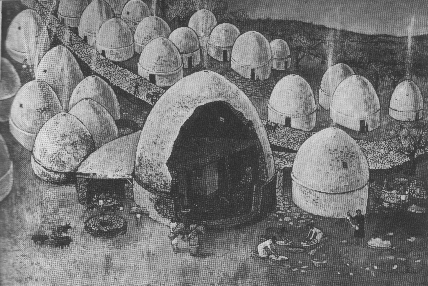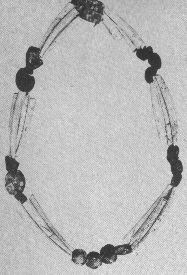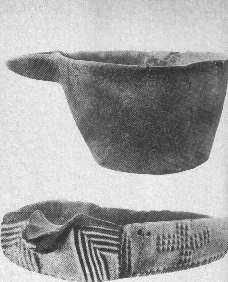|
|
|

As far as we know Cyprus has always been an island, at least since the appearance of man in the Near East. Cyprus faces the south coast of Anatolia on the one hand, and that of Syria and the Lebanon on the other both areas rich in Palaeolithic remains.
The aceramic culture of Khirokitia - is dated by the C-14 method to the sixth millennium B C (6020, 5850 and 5800 B C). In spite of this comparatively late date - perhaps the natural result of its comparative isolation - this culture in many respects resembles such Natufian sites as Ain Mallaha or Pre-Pottery A Jericho. The origins of the culture are utterly unknown, but earlier phases remain to be discovered, if not in Cyprus itself, then somewhere on the Asiatic mainland. Its distribution roughly covers the island and the import of obsidian points to contact with Anatolia. The discovery of a site of this period at the very end of the dagger-like Karpas peninsula is significant, for it points straight at the mouth of the Calycadnus valley, the old trade route from the Anatolian Plateau to the Mediterranean coast. It also points to Ras Shamra, another early maritime site in north Syria and to the Amuq (plain of Antioch) where a stone vessel of Khirokitia type was found in levels of the Amuq A period (before 6000 BC). Seafaring was evidently established at this period and one of the sites, Petra tou Limniti, was established on a small island in Morphou Bay.
Two features of the culture have no parallels elsewhere; a flint industry of peculiar type which is not microlithic, possibly a descendant of the Upper Palaeolithic, and secondly a round-headed (brachycephalic) population at Khirokitia itself, perhaps the result of isolation or a habit of cranial deformation.
Khirokitia is not a mound, but a hill site about 2 5 0 metres in diameter situated within a bend of the Maroniou river. It commands a view down to the south coast, which is a few miles away. A paved stone road running for about 2oo metres through the settlement was traced leading down the hill towards the river. Forty-eight round houses of tholos type were excavated, a small proportion of the entire settlement, which may have contained a thousand houses and a population running into the thousands, for Khirokitia was evidently more than a village. Three main levels of buildings were found and the extremely solid construction of the houses indicates a considerable duration of the settlement.
These round houses, varying in diameter from 3 to 4 and 7 to 8 metres, frequently had double walls, built of local limestone. Their superstructure consisted of a dome of stone, brick or light materials. In the larger houses two solid stone pillars probably supported an upper storey or wooden floor, reached by a ladder and it was here that people probably slept. Similar arrangements prevailed in the workshops of Beidha. Hearths, platforms for sleeping, and pits in the floor are frequent. Seats, windows and cup-boards were found in the wall or in the stone pillars. The doorways had high thresholds, to keep out rain and mud, and a few stone steps led down into the room. Several compounds were found consisting of one large beehive house, and several others used as kitchens, workshops for grinding corn, etc. Courtyards were often paved with flat stones and circular tables show where the food was eaten. Some corridors appear to have been roofed and access to the courtyards was gained by ramps leading from the central street. The general impression is one of great efficiency and good organisation.
These people practised burial among the houses or below the floors, and single contracted burials appear to have been the rule. Objects were deposited with the dead; stone bowls, frequently ceremonially broken, and necklaces with women, and pins and other offerings with men or children. From the rich burial gifts of the women it may be deduced that they were man's equal.
Something is known about the dress of these Neolithic people. Weaving is attested by the presence of spindlewhorls and garments were probably of wool. They were fastened with bone pins, and sewn with needles. Personal ornament is represented by stone beads, pendants and bracelets; and necklaces of dentalia shells, carnelian and greyish-green pikrite. Bone was used for handles of stone tools, for awls, pins and needles. Maces of polished stone were used as weapons.

Reconstruction of the Early Neolithic settlement of Khirokitia in Cyprus showing domed houses, corridors, workshops and main road leading through the settlement
The polished stone industry was highly developed. In the lowest building level some attempts were made to produce clay pots, without apparent success. Spouted stone bowls of greenish-grey andesite - a local stone - and shallow dishes of round, square or roughly oblong shapes are the most common forms. Many of these are up to a foot in length. They are frequently plain but some of the finest are decorated with incisions or with plastic bands, rows of knobs and ribs sometimes reminiscent of wooden vessels or basketry. Some of the bowls have handles with thumb grips, like the later horned handles; others are ornamented with human or animal heads (sheep and bulls). Shallow round dishes, like those of Ain Mallaha or Jericho B, may have been used as lamps.
Figurines are not uncommon - there are stone standing figures with schematised heads and no indication of sex, and there is one fine woman's head in unbaked clay. Engraved or carved pebbles of uncertain use are common. Of the economy of the Khirokitia settlement we know but little; no actual grain was found, but sickle blades, querns and grinding stones abound. There is evidence for domesticated sheep and goats and possibly pig. Apart from obsidian, only local materials were used. The end of the culture is as mysterious as its beginning - Khirokitia and other sites were deserted and only at Troulli on the north coast is the next stage represented stratigraphically on top of the earlier remains. This phase (Neolithic 1 B) is characterised by the first pottery, painted in red on cream, highly burnished and probably closely related to the Hacilar 1 ware (c. 5 2 5 0-5 000 B C) of south- western Anatolia, whence the newcomers may have come.


Necklace of carnelian beads and tusk-shaped dentalia shells from a woman's grave in Khirokitia. Right, spouted bowl and basin of andesite, a volcanic stone. Note the decoration on the basin, probably inspired by basket work, and the two holes indicating an ancient repair
![]()